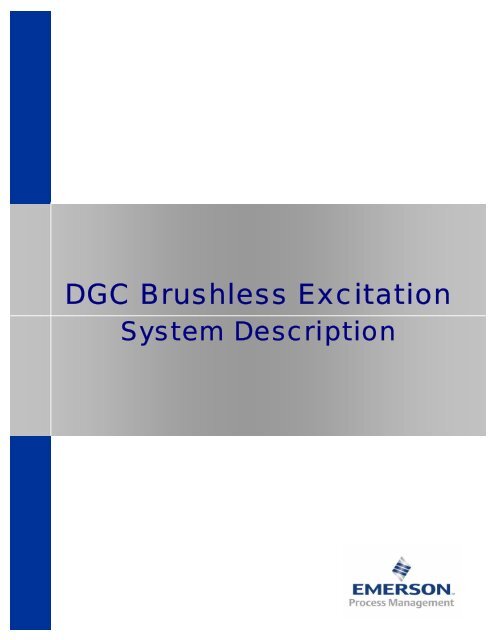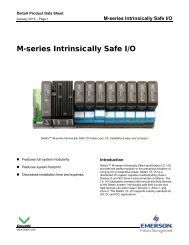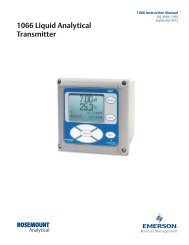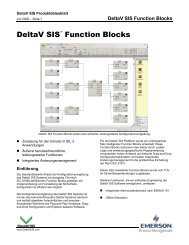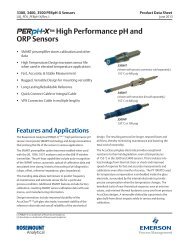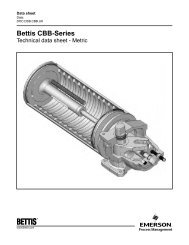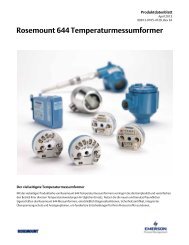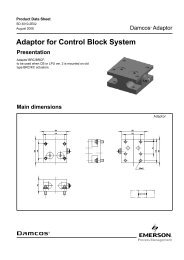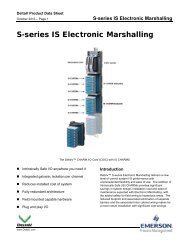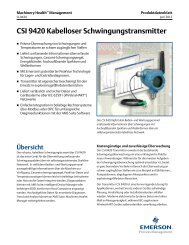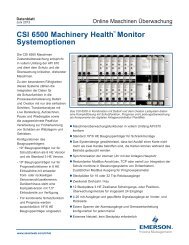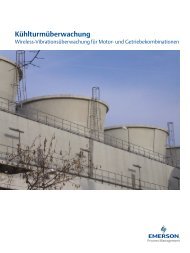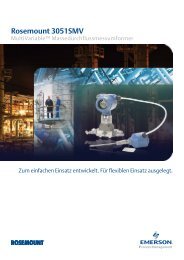DGC Brushless Excitation - Emerson Process Management
DGC Brushless Excitation - Emerson Process Management
DGC Brushless Excitation - Emerson Process Management
You also want an ePaper? Increase the reach of your titles
YUMPU automatically turns print PDFs into web optimized ePapers that Google loves.
<strong>DGC</strong> <strong>Brushless</strong> <strong>Excitation</strong><br />
System Description
Table of Contents<br />
<strong>DGC</strong> <strong>Brushless</strong> <strong>Excitation</strong><br />
System Description<br />
1.0 INTRODUCTION 4<br />
2.0 BRUSHLESS EXCITATION SYSTEM 4<br />
2.1 Permanent Magnet Generator 4<br />
2.2 AC Exciter 5<br />
2.3 Rectifier Wheel 5<br />
2.4 Voltage Regulator 5<br />
3.0 <strong>DGC</strong> VOLTAGE REGULATOR SYSTEM 5<br />
3.1 Exciter Field Breaker 6<br />
3.2 Digital Generator Controller 6<br />
3.3 VME Modules 6<br />
3.3.a Single Board Computer 7<br />
3.3.b Analog and Digital I/O Unit (ADIOU) 7<br />
3.3.c I/O Interface Control Unit (IOICU) 7<br />
3.3.d VME Power Supply 8<br />
3.3.e Network Hub Module 8<br />
3.4 Field Interface Panel 8<br />
3.5 Base Adjuster 10<br />
3.6 Power Amplifiers 11<br />
3.7 Field Breaker 12<br />
3.8 Control Switches and Indications 12<br />
3.8.a Field Breaker Control Switch 12<br />
3.8.b Regulator Mode Control Switch 12<br />
3.8.c Voltage Adjuster Control Switch 13<br />
3.8.d Base Adjuster Control Switch 13<br />
3.8.e Regulator Output Meter 13<br />
3.9 Feedback Signals 13<br />
3.9.a Generator Terminal Voltage 13<br />
3.9.b Generator Stator Current 14<br />
3.9.c Exciter Field Current 14<br />
4.0 CONTROL SOFTWARE 14<br />
4.1 Operating and Control Modes 14<br />
4.1.a OFF Mode - Base Control 14<br />
4.1.b Test Mode - Base Control 14<br />
4.1.c ON Mode – Automatic Voltage Control 15<br />
4.1.d FORCED Mode – Base Control 15<br />
© <strong>Emerson</strong> <strong>Process</strong> <strong>Management</strong> Power & Water Solutions. - 2 -<br />
PWS_005075 [3]
<strong>DGC</strong> <strong>Brushless</strong> <strong>Excitation</strong><br />
System Description<br />
4.2 Basic Operation of the Voltage Regulator 16<br />
4.3 Automatic AC Voltage Control Software 17<br />
4.3.a Voltage Control 18<br />
4.3.b Setpoint 18<br />
4.3.c Voltage Feedback Signal 18<br />
4.3.d Load Compensation 18<br />
4.3.e Line Compensation 19<br />
4.4 Controller Characteristics 19<br />
4.4.a Proportional Action 19<br />
4.4.b High Initial Response 20<br />
4.4.c Integral Action 20<br />
4.4.d Derivative Action 20<br />
4.5 Limiters 20<br />
4.5.a Maximum <strong>Excitation</strong> Limiter 20<br />
4.5.b Minimum <strong>Excitation</strong> Limiter 21<br />
4.5.c Volts/Hz Limiter 22<br />
4.6 Protection Software 22<br />
4.6.a Over <strong>Excitation</strong> Protection 22<br />
4.6.b Volts/Hz Protection 24<br />
4.6.c Minimum <strong>Excitation</strong> Protection 24<br />
4.6.d <strong>Excitation</strong> Removal 25<br />
5.0 LEGAL NOTICE 26<br />
© <strong>Emerson</strong> <strong>Process</strong> <strong>Management</strong> Power & Water Solutions. - 3 -<br />
PWS_005075 [3]
1.0 Introduction<br />
<strong>DGC</strong> <strong>Brushless</strong> <strong>Excitation</strong><br />
System Description<br />
<strong>Emerson</strong>’s <strong>Excitation</strong> System is a versatile combination of elements which can be adapted to<br />
provide finely controlled excitation to synchronous machines over a wide range of capacities.<br />
The heart of the excitation system is the Digital Generator Controller (<strong>DGC</strong>). The Digital Generator<br />
Controller is a VME-based computer system running <strong>Emerson</strong>’s proprietary <strong>DGC</strong> application<br />
software. The software provides all of the features required for precise control of the generator<br />
under normal and fault conditions.<br />
The <strong>DGC</strong> computer system is backed up by an independent manual control system which provides<br />
a high level of reliability for operation of the unit. The manual system is completely independent of<br />
the <strong>DGC</strong> computer, such that loss of the computers will not result in a loss of excitation. This<br />
document describes <strong>Emerson</strong>’s <strong>DGC</strong> as it is applied in a brushless excitation system.<br />
2.0 <strong>Brushless</strong> <strong>Excitation</strong> System<br />
On large generators, the field windings are mounted on the rotor so excitation current must be<br />
somehow transferred to the generator shaft. One way to accomplish this is to use slip rings and<br />
brushes; however, the disadvantage of that solution is that constant maintenance is required.<br />
The key to eliminating brushes is to generate the excitation current where it is to be used, on the<br />
turbine generator shaft. This task is accomplished by building a generator whose armature<br />
windings are mounted on the turbine generator shaft. In this way, the electrical energy for field<br />
excitation is transferred to the generator field windings by magnetic fields instead of brushes and<br />
slip rings.<br />
Figure 1: <strong>Brushless</strong> Exciter<br />
As shown in Figure 1, the <strong>Brushless</strong> Exciter is comprised of three components, all of which are<br />
contained in the Exciter housing. The Voltage Regulator is a separate component but is a vital part<br />
of the excitation system.<br />
2.1 Permanent Magnet Generator<br />
The Permanent Magnet Generator (PMG) is an AC generator mounted at the end of the exciter<br />
shaft. The PMG field is provided by permanent magnets which are mounted on the rotor. The<br />
armature windings are on the stator. It produces 3-Phase, 120 VAC at 420 Hz for use by the<br />
Voltage Regulator. The Voltage Regulator rectifies the AC and supplies DC current to the AC<br />
Exciter field windings.<br />
© <strong>Emerson</strong> <strong>Process</strong> <strong>Management</strong> Power & Water Solutions. - 4 -<br />
PWS_005075 [3]
<strong>DGC</strong> <strong>Brushless</strong> <strong>Excitation</strong><br />
System Description<br />
2.2 AC Exciter<br />
The AC Exciter is also an AC Generator. It is mounted in the middle of the exciter shaft. This<br />
generator is constructed somewhat backwards, in that the armature windings are wound on the<br />
rotor, and the field windings are mounted on the stator. The current flow to the field windings of the<br />
AC Exciter is controlled by the voltage regulator. The output of the AC Exciter is multi-phase AC,<br />
which is carried through insulated conductors, along the exciter shaft to the Rectifier Wheel.<br />
2.3 Rectifier Wheel<br />
The Rectifier Wheel is a multi-phase full wave rectifier which converts the AC output of the AC<br />
Exciter into DC for application to the Main Generator Field. Each leg of the rectifier contains<br />
multiple rectification diodes with fuses. The fuses are designed to remove a leg of the rectifier from<br />
the circuit if the diode should short.<br />
The DC output of the Rectifier Wheel is wired to the generator shaft coupling insulated conductors<br />
inside the shaft. The exciter conductors are connected to the Main Generator field windings<br />
through bolted connections located inside the coupling between the Exciter shaft and the Main<br />
Generator shaft. Smaller units have the connection on the outside of the shaft.<br />
2.4 Voltage Regulator<br />
The Voltage Regulator controls the magnitude of the field current to the AC Exciter. Therefore, the<br />
voltage regulator controls the AC output voltage of the AC Exciter. The Rectifier Wheel simply<br />
converts the AC Exciter output into DC for application to the main generator field. Therefore, the<br />
voltage regulator directly controls the field current in the main generator. Having control of main<br />
generator field current means that the voltage regulator controls generator output voltage.<br />
3.0 <strong>DGC</strong> Voltage Regulator System<br />
The <strong>DGC</strong> hardware is normally supplied as a redundant computer system with an independent<br />
manual back-up system, providing high reliability and serviceability. Single channel systems are<br />
sometimes supplied for less critical applications.<br />
Figure 2: <strong>DGC</strong> <strong>Excitation</strong> System for <strong>Brushless</strong> Exciter<br />
© <strong>Emerson</strong> <strong>Process</strong> <strong>Management</strong> Power & Water Solutions. - 5 -<br />
PWS_005075 [3]
<strong>DGC</strong> <strong>Brushless</strong> <strong>Excitation</strong><br />
System Description<br />
3.1 Exciter Field Breaker<br />
The Exciter Field Breaker controls the application of AC power to the system. AC power is typically<br />
supplied from a Permanent Magnet Generator which is part of the <strong>Brushless</strong> Exciter. Some<br />
systems may obtain AC power from a station service source.<br />
The Exciter Field Breaker is typically a molded case breaker mounted in a draw out assembly.<br />
Alternately, a latching contactor may be supplied for lower current applications.<br />
3.2 Digital Generator Controller<br />
The Digital Generator Controller is a customized compute r system which runs <strong>Emerson</strong>’s<br />
proprietary software to make it act as a voltage regulator. The components of the <strong>DGC</strong> computer<br />
conform to the VME Bus standard, which is an internationally recognized standard for the design<br />
and packaging of industrial electronic systems. The VME Bus standard is supported by an active<br />
syndication of manufacturers worldwide and is popular in the industrial, telecommunication and<br />
military marketplaces. VME Bus architecture was selected for use in the <strong>DGC</strong> based on its high<br />
reliability, flexibility and rugged performance. The wide support of the VME Bus standard ensures<br />
that the <strong>DGC</strong> will avoid the rapid obsolescence issues that naturally accompany the design and<br />
construction of proprietary computer systems.<br />
3.3 VME Modules<br />
Each channel of the <strong>DGC</strong> is comprised of four VME modules. In a redundant <strong>DGC</strong>, the two<br />
channels share an Ethernet hub module located in the center of the chassis. The following<br />
paragraphs describe the functions of each VME module.<br />
VME Modules, Redundant <strong>DGC</strong><br />
© <strong>Emerson</strong> <strong>Process</strong> <strong>Management</strong> Power & Water Solutions. - 6 -<br />
PWS_005075 [3]
<strong>DGC</strong> <strong>Brushless</strong> <strong>Excitation</strong><br />
System Description<br />
3.3.a Single Board Computer<br />
The computers used in each channel of the <strong>DGC</strong> are state-of-the art, industrial grade Single Board<br />
Computers (SBC), featuring a high-speed Pentium processor, a serial port, an Ethernet port and<br />
various other features. System operating software and calibration constants are stored in nonvolatile<br />
“Flash” memory so that all programming is retained on power loss. The SBC uses no<br />
moving parts to ensure rugged and reliable performance.<br />
The two processors share information via the Ethernet port. The video output is normally<br />
connected to a flat panel display. Keyboard and mouse connectors are available on the front of the<br />
module.<br />
All field I/O communication is accomplished across the bus connections on the VMEbus Backplane<br />
to the adjacent ADIOU module.<br />
3.3.b Analog and Digital I/O Unit (ADIOU)<br />
The Analog and Digital I/O Unit (ADIOU) module provides analog and digital input and output<br />
capabilities for the <strong>DGC</strong> using “Industry Pack” (IP) technology. IP modules are small circuit cards<br />
that provide specific I/O functions that can be mixed and matched to create a system with the<br />
desired types and quantities of I/O. The ADIOU circuit card is a “carrier card” that provides<br />
mechanical support and electrical interfaces to support four IP modules.<br />
The four IP modules utilized on the ADIOU are:<br />
• Slots A and B: 48-Point Programmable Digital I/O modules. Of the 96 available points,<br />
36 are configured as digital inputs and 60 are configured as digital outputs. The digital<br />
inputs provide the controllers with the ability to monitor switch positions, breaker<br />
positions and alarm conditions. The digital outputs enable the controllers to energize<br />
lamps, generate alarms, warnings and generator trips. Digital inputs and outputs<br />
operate at 5 VDC level.<br />
• Slot C: 16-channel A/D Converter which allows the controllers to monitor a variety of<br />
analog signals. The module supports monitoring of both AC and DC field signals in the<br />
range of + 10 Volts.<br />
• Slot D: 16-channel D/A Converter module which provides the controllers with the ability<br />
to generate + 10 VDC signals for control and indication.<br />
Communication with the single board computers is carried out across the VMEbus Backplane.<br />
Field input and output signals are connected through ribbon cables on the front of the card to the<br />
front edge of the I/O Interface Control Unit (IOICU).<br />
3.3.c I/O Interface Control Unit (IOICU)<br />
The IOICU module provides the circuitry to scale, buffer and filter the signal types associated with<br />
synchronous machine voltage regulators. In a single channel system, all of the field connections<br />
are made through a single IOICU, whereas a redundant unit has two IOICU modules whose outputs<br />
must be paralleled to fully implement the redundancy features. When configured as a redundant<br />
unit, the IOICU ultimately determines which <strong>DGC</strong> channel is in control of the system outputs.<br />
The IOICU receives and conditions analog input signals from the field in three ranges: 150 VAC, 6<br />
VAC and + 10 VDC, converting them to the range of + 10 Volts.<br />
The IOICU buffers the outputs and provides the capability to “tristate” each of the analog outputs as<br />
part of the redundancy features of the <strong>DGC</strong>.<br />
© <strong>Emerson</strong> <strong>Process</strong> <strong>Management</strong> Power & Water Solutions. - 7 -<br />
PWS_005075 [3]
<strong>DGC</strong> <strong>Brushless</strong> <strong>Excitation</strong><br />
System Description<br />
The IOICU receives and conditions digital input signals from the field in three ranges: 125 VDC, 15<br />
VDC and 5 VDC and converts them to the 5 VDC logic states. Digital inputs are optically isolated.<br />
The IOICU converts the logic states to dry relay contacts and provides the capability to “tristate”<br />
each of the digital outputs as part of the redundancy features of the <strong>DGC</strong>.<br />
3.3.d VME Power Supply<br />
Each <strong>DGC</strong> channel is equipped with its own rack mounted, quad output, power supply module.<br />
Each Power Supply is fed by two independent power sources; Station 125 VDC system and an<br />
independent 120 VAC source.<br />
Each Power Supply provides dedicated power to its respective channel of the <strong>DGC</strong> at +5 VDC, +12<br />
VDC and -12 VDC. Each power supply also provides auctioneered +48 VDC to the IOICU<br />
Backplane for distribution to the Field Interface Panel and the cooling fans.<br />
3.3.e Network Hub Module<br />
The Network Hub Module provides a hub for Ethernet communication with the <strong>DGC</strong> channels. The<br />
two single board computers also use the network connection for inter-processor communications.<br />
The network connection is also used by the <strong>DGC</strong> configuration software and optional SCADA<br />
software.<br />
3.4 Field Interface Panel<br />
The Field Interface Panel (FIP) is a large printed circuit card with a purpose to provide simple and<br />
reliable connections between the <strong>DGC</strong> computer and the field. The FIP connects to the IOICU<br />
backplane using prefabricated ribbon cables.<br />
FIP2 for WTA Retrofit Applications / FIP3 for Stand Alone Applications<br />
The field terminations on the FIP are designed to accommodate the physical connections for two<br />
distinctly different <strong>DGC</strong> applications. For the WTA Retrofit application, the FIP connects to the field<br />
using four large AMP connectors, which are compatible with the existing WTA Regulator cable<br />
harnesses. For all other applications, the FIP connects to the field using “euro” style terminal blocks<br />
mounted on the periphery of the board.<br />
The FIP is largely a passive device. The only active components mounted on the FIP are<br />
interposing relays and LEDs that are assigned to some of the digital output circuits to accommodate<br />
higher contact rating requirements.<br />
© <strong>Emerson</strong> <strong>Process</strong> <strong>Management</strong> Power & Water Solutions. - 8 -<br />
PWS_005075 [3]
<strong>DGC</strong> <strong>Brushless</strong> <strong>Excitation</strong><br />
System Description<br />
© <strong>Emerson</strong> <strong>Process</strong> <strong>Management</strong> Power & Water Solutions. - 9 -<br />
PWS_005075 [3]
<strong>DGC</strong> <strong>Brushless</strong> <strong>Excitation</strong><br />
System Description<br />
3.5 Base Adjuster<br />
The emergency manual adjuster or Base Adjuster is an independent modular PLC-based device<br />
which acts as the controller for manual operation of the excitation system. When in manual control,<br />
the adjuster maintains a constant exciter field current. The emergency manual adjuster will be<br />
controlled by the Base Adjuster control switch.<br />
OPTO 22 Programmable Adjuster Replacement (OPTO PAR)<br />
When the <strong>DGC</strong> is in automatic control the adjuster follows the automatic signal to ensure a<br />
bumpless transfer between auto and manual operations.<br />
The adjuster has an independently powered track/hold backup circuit. An alarm is sent to the <strong>DGC</strong><br />
if the base adjuster senses an internal problem.<br />
© <strong>Emerson</strong> <strong>Process</strong> <strong>Management</strong> Power & Water Solutions. - 10 -<br />
PWS_005075 [3]
<strong>DGC</strong> <strong>Brushless</strong> <strong>Excitation</strong><br />
System Description<br />
3.6 Power Amplifiers<br />
The Power Amplifiers come in either a drawer-mounted version or a panel-mounted version. Both<br />
versions consist of two basic components: a firing circuit and a rectifier bridge.<br />
The firing circuit generates the firing pulses to control the SCR’s in the rectifier bridge. The demand<br />
signal to the trigger circuit is the summation of the DC control signals from the <strong>DGC</strong> and the Base<br />
Adjuster.<br />
The rectifier bridge uses SCRs to convert 3-phase AC into DC current. The SCR’s pass current<br />
flow in response to the gating pulses from the firing circuitry. The output current can be controlled<br />
from zero to maximum amps. An alarm is provided to alert the operator of a problem with the<br />
rectification process.<br />
Integrated Power Amplifier<br />
© <strong>Emerson</strong> <strong>Process</strong> <strong>Management</strong> Power & Water Solutions. - 11 -<br />
PWS_005075 [3]
<strong>DGC</strong> <strong>Brushless</strong> <strong>Excitation</strong><br />
System Description<br />
For WTA retrofits, the Integrated Power Amplifier incorporates the functionality of the Firing and<br />
Power drawers into one drawer. The Firing Drawers are removed and discarded and the Power<br />
Amplifiers are replaced with new Integrated Power Amplifiers. The Integrated Power Amplifier has<br />
the same form and fit as the existing WTA<br />
Power Drawer, utilizing the existing racking<br />
mechanism and bus-bar connections in the rear.<br />
A new cable and connector arrangement is<br />
installed to support the other needed<br />
connections.<br />
For all other applications, the Power Amplifier<br />
components are panel mounted. The panel<br />
dimensions and bolting patterns are designed to<br />
facilitate installation into a variety of existing<br />
cabinet configurations. The Power Amplifier<br />
Panel is typically constructed with redundant<br />
SCR Bridges; however, single channel panels<br />
are available.<br />
Panel Mounted Power Amplifier<br />
3.7 Field Breaker<br />
The DB25 (or DB15) Field Breaker is replaced with a Square D MasterPac breaker assembly which<br />
is configured as a form, fit and function retrofit. The new breaker assembly adapts to the existing<br />
rails with a carriage that becomes a permanent part of the cubicle. The MasterPac breaker carriage<br />
is permanently mounted inside the adapter carriage. The MasterPac breaker racks into its own<br />
carriage and provides the same functionality as the existing breaker.<br />
3.8 Control Switches and Indications<br />
The design of the <strong>DGC</strong> <strong>Excitation</strong> System is such that the operation of the new voltage regulator is<br />
largely unchanged from the old regulator. The control room interfaces are retained and their<br />
functionalities are nearly identical.<br />
3.8.a Field Breaker Control Switch<br />
The Field Breaker Control Switch (41CS) allows the operator to close the 41Breaker (contactor) to<br />
initiate excitation. The actual position of the 41 device is indicated with lamps.<br />
3.8.b Regulator Mode Control Switch<br />
The Regulator Mode Control Switch (90CS) is a three-position switch that allows the operator to<br />
select the operating mode of the regulator. The actual operating mode is indicated with three<br />
lamps. The state of the lamps is controlled by digital outputs from the <strong>DGC</strong>.<br />
© <strong>Emerson</strong> <strong>Process</strong> <strong>Management</strong> Power & Water Solutions. - 12 -<br />
PWS_005075 [3]
<strong>DGC</strong> <strong>Brushless</strong> <strong>Excitation</strong><br />
System Description<br />
3.8.c Voltage Adjuster Control Switch<br />
The Voltage Adjuster Control Switch (90VCS) is used to establish the terminal voltage setpoint for<br />
the voltage regulator. The range of the switch is typically calibrated for 90% to 110% of the<br />
generator’s rated voltage.<br />
The Voltage Adjuster Control Switch position is indicated on an analog meter, driven by an analog<br />
output signal from the <strong>DGC</strong>. In the absence of a meter, the position may be indicated with a set of<br />
lamps. Digital outputs are available to drive indicating lamps or for status indication of the voltage<br />
adjuster position.<br />
The Voltage Adjuster Control Switch has “pre-position” capabilities that allow the adjuster to be<br />
forced to a specified position upon request.<br />
3.8.d Base Adjuster Control Switch<br />
The Base Adjuster (PAR) provides control of excitation when not in automatic voltage control. The<br />
Base Adjuster is typically calibrated for the full range of power amplifier conduction which results in<br />
zero to maximum amps of field current.<br />
The Base Adjuster position is indicated on an analog meter, driven by an analog output signal from<br />
the PAR. In the absence of a meter, the position may be indicated with a set of lamps. Digital<br />
outputs are available to drive indicating lamps or for status indication of the voltage adjuster<br />
position.<br />
The Base Adjuster has “pre-position” capabilities that allow the adjuster to be forced to a specified<br />
position upon request.<br />
The Base Adjuster operates in a “follower” mode when the <strong>DGC</strong> is in automatic control. This is a<br />
significant safety feature because the Base Adjuster will always be adjusting its output to bring the<br />
output of the regulator back to zero. The practical result is that if the regulator experiences a failure<br />
or is restricted from producing a regulator output, the Base Adjuster will maintain the generator<br />
voltage at the same level.<br />
The PAR alarm output is monitored by the <strong>DGC</strong> as a condition that will generate an alarm. This<br />
alarm is usually configured to generate the <strong>DGC</strong> Trouble Alarm output.<br />
3.8.e Regulator Output Meter<br />
The Regulator Output Meter in the control room provides indication of the control signal value when<br />
it is not in the OFF mode.<br />
The Regulator Output Meter signal is the final control signal of the <strong>DGC</strong>. It is supplied to the firing<br />
circuits to control the amount of excitation current supplied to the Generator. Since the reliability of<br />
the Regulator Control Output Meter is critical to the operation of the <strong>DGC</strong>, the signal is selfmonitored<br />
by the <strong>DGC</strong> to ensure that it is operable and accurate.<br />
3.9 Feedback Signals<br />
The <strong>DGC</strong> requires several Feedback Signals in order to provide control and protection for the<br />
generator.<br />
3.9.a Generator Terminal Voltage<br />
Generator Terminal Voltage is the principle feedback signal for controlling the generator. The signal<br />
is taken from the Regulator PT’s. It is also used as an input to the Limiters and Protection features.<br />
© <strong>Emerson</strong> <strong>Process</strong> <strong>Management</strong> Power & Water Solutions. - 13 -<br />
PWS_005075 [3]
<strong>DGC</strong> <strong>Brushless</strong> <strong>Excitation</strong><br />
System Description<br />
3.9.b Generator Stator Current<br />
Generator Stator Current is taken from Generator CT’s. It is used to calculate VARs so that the<br />
<strong>DGC</strong> can compensate the generator output for changes in VAR loading. It is also used as an input<br />
to the Limiters and Protection features.<br />
3.9.c Exciter Field Current<br />
Exciter Field Current is taken from a shunt inside the voltage regulator cubicle. It is used in the <strong>DGC</strong><br />
control software as a stabilizing signal to dampen the response of the regulator during transients. It<br />
is also used as an input to the Limiters and Protection features.<br />
4.0 Control Software<br />
The <strong>DGC</strong> is continuously running its Control Software. The Control Software performs four basic<br />
functions: it establishes the operating mode of the system, it monitors and controls the generator<br />
output voltage, it provides “limiting” of excitation under abnormal operating conditions and it<br />
provides generator protection under fault conditions.<br />
4.1 Operating and Control Modes<br />
The mode of the regulator determines how the operator controls the generator output. The<br />
operating mode is selected by the operator using the 90/CS but the actual mode is determined by<br />
the <strong>DGC</strong> software.<br />
4.1.a OFF Mode - Base Control<br />
In traditional OFF Mode, the <strong>DGC</strong> does not actively control excitation. Using the Base Adjuster, the<br />
operator manually raises or lowers excitation current as desired to adjust Machine Voltage, VARs<br />
and Power Factor. The <strong>DGC</strong> protection is still operating.<br />
Key points:<br />
• The operator uses the Base Adjuster to control the generator output voltage<br />
• The <strong>DGC</strong> output is held at zero<br />
• The Protection functions are operable<br />
4.1.b Test Mode - Base Control<br />
In TEST Mode, excitation current is still manually controlled by the operator using the Base<br />
Adjuster.<br />
TEST Mode was historically used by the operators to "null" the regulator output prior to placing the<br />
regulator into service. The <strong>DGC</strong> is normally configured to automatically null the regulator by moving<br />
the voltage adjuster to match the current generator voltage.<br />
If the Voltage Adjuster is moved, the regulator output meter will still respond to verify the operability<br />
of the regulator. However, when the voltage adjuster switch is release, the regulator output will<br />
automatically return to zero as the voltage adjuster tracks the current generator voltage.<br />
© <strong>Emerson</strong> <strong>Process</strong> <strong>Management</strong> Power & Water Solutions. - 14 -<br />
PWS_005075 [3]
Key points:<br />
<strong>DGC</strong> <strong>Brushless</strong> <strong>Excitation</strong><br />
System Description<br />
• The operator uses the Base Adjuster to control the generator output voltage<br />
• The Voltage Adjuster tracks the generator terminal voltage (if so configured)<br />
• The <strong>DGC</strong> hardware output is held at 0 VDC<br />
• The Protection functions are operable<br />
All alarms are cleared by transitioning into TEST mode.<br />
4.1.c ON Mode – Automatic Voltage Control<br />
In AUTO (ON) mode, the <strong>DGC</strong> has full range control of excitation current. The operator establishes<br />
a setpoint using the Voltage Adjuster switch. The <strong>DGC</strong> monitors the actual generator terminal<br />
voltage and automatically adjusts excitation to maintain the generator output at the setpoint.<br />
Getting into ON mode requires four conditions to be met for the usual configuration:<br />
1. The field breaker must be closed<br />
2. The PT signals must be valid<br />
3. The regulator control switch must be in the ON position<br />
4. The automatic controller error signal must be less than the limit<br />
When in automatic, additional features are in place to prevent the generator from being operated<br />
outside its design limits.<br />
Key Points:<br />
• The operator uses the Voltage Adjuster to control the generator output variable<br />
• The Base Adjuster will only momentarily change generator output voltage because<br />
the automatic controller opposes any changes, so it should not be used<br />
• The generator terminal voltage is actively controlled by the <strong>DGC</strong> utilizing closed<br />
loop feedback control<br />
• The Limiters are operable<br />
• The Protection functions are operable<br />
4.1.d FORCED Mode – Base Control<br />
Under certain contingent circumstances, it is necessary and/or prudent to force the <strong>DGC</strong> out of<br />
automatic, back in to a manual mode. In the FORCED Mode, the operating mode is identical to the<br />
OFF Mode.<br />
The request to force manual operation may be generated internally by the protective features of the<br />
<strong>DGC</strong> or externally at the customer’s discretion.<br />
© <strong>Emerson</strong> <strong>Process</strong> <strong>Management</strong> Power & Water Solutions. - 15 -<br />
PWS_005075 [3]
The contingency conditions are:<br />
• Any Alarm that enforces the NO AUTO restriction i.e., Bad PT’s<br />
• Customer input requests a Regulator Trip<br />
• OXP requests a Regulator Trip<br />
• VHP requests a Regulator Trip<br />
<strong>DGC</strong> <strong>Brushless</strong> <strong>Excitation</strong><br />
System Description<br />
In the FORCED Mode, the OFF lamp blinks at approximately 2 Hz until the fault condition is cleared<br />
and the Operator returns the control switch to TEST position.<br />
Figure 3: Simplified Voltage Regulator Control Loop<br />
4.2 Basic Operation of the Voltage Regulator<br />
The generator output voltage is directly proportional to the magnitude of the excitation current.<br />
<strong>Excitation</strong> current to the generator field is supplied by the exciter output, which in turn receives its<br />
stimulus from the power amplifiers. The power amplifiers and exciter are typically capable of<br />
producing more than 130% of the rated excitation current. The excess capacity is provided to<br />
support rapid transient response.<br />
The magnitude of the excitation current is directly proportional to the excitation demand. <strong>Excitation</strong><br />
demand is the sum of two signals: the Base and the Regulator Output.<br />
The Base signal is controlled by the operator using the Base Adjuster control switch. It is capable<br />
of providing an excitation demand from 0% to 100%. The Base signal is also adjusted automatically<br />
when it receives the follower command.<br />
© <strong>Emerson</strong> <strong>Process</strong> <strong>Management</strong> Power & Water Solutions. - 16 -<br />
PWS_005075 [3]
<strong>DGC</strong> <strong>Brushless</strong> <strong>Excitation</strong><br />
System Description<br />
When the <strong>DGC</strong> is in OFF or TEST modes, the regulator output signal is held at 0%, thus the<br />
excitation demand is entirely controlled by the Base signal.<br />
The Regulator Output signal is produced by the <strong>DGC</strong>. The <strong>DGC</strong> is usually configured as a<br />
proportional only controller, receiving a positive setpoint from the Voltage Adjuster (+) and a<br />
negative feedback signal from the generator. The two signals are added together to produce an<br />
“error signal” which can be positive or negative. Integral control can be utilized if desired, usually<br />
seen when a numeric setpoint is provided. In lieu of <strong>DGC</strong> integral control, the Base following action<br />
acts as an integrator.<br />
If the generator voltage is too low, then the error signal is positive, calling for more excitation. If the<br />
generator voltage is too high, then the error signal is negative, calling for less excitation. If the<br />
generator voltage is equal to the setpoint, then the regulator output is zero. The Regulator Output is<br />
capable of providing an excitation demand from –100% to +100%.<br />
When the <strong>DGC</strong> operational mode implements the AC or DC control type, the Regulator Output is<br />
permitted to pass. If the regulator output signal is zero, then the excitation demand is equal to the<br />
Base signal. If the regulator output goes positive, then the excitation demand increases above the<br />
base. If the regulator output goes negative, then the excitation demand decreases to a value below<br />
the base.<br />
If the operator wishes to raise the output voltage of the generator, then he raises the voltage<br />
adjuster. The setpoint signal is greater than the feedback signal so the error signal is positive. The<br />
regulator output signal goes positive, adding to the base signal, causing the excitation demand to<br />
be increased. <strong>Excitation</strong> current increases and generator voltage goes up.<br />
If the operator wishes to lower the output voltage of the generator, then he lowers the voltage<br />
adjuster. The setpoint signal becomes less than the feedback signal so the error is negative. The<br />
regulator output signal goes negative, subtracting from the base signal, causing the excitation<br />
demand to be reduced. <strong>Excitation</strong> current decreases and generator voltage goes down.<br />
Due to the inherent voltage drop of the generator, as the generator is loaded, the output voltage will<br />
drop correspondingly. If the generator voltage drops below the setpoint, then the error signal is<br />
positive. If the generator is unloading the output voltage will rise correspondingly. If the generator<br />
voltage rises above the setpoint, then the error signal is negative.<br />
While in automatic, the Base Adjuster is not able to change terminal voltage because the regulator<br />
will fight against it. For example, if the operator raises the Base Adjuster, the excitation demand will<br />
increase. <strong>Excitation</strong> current increases and generator voltage goes up. The feedback goes up<br />
which makes the regulator output signal move in the negative direction. The reduction in regulator<br />
output causes the excitation demand to return to its initial starting point. <strong>Excitation</strong> current will drop<br />
back to its starting point and the generator output voltage will return to its starting point.<br />
4.3 Automatic AC Voltage Control Software<br />
The term AC control is applied when the controlled variable is measured from the generator<br />
terminals and is thus an AC quantity. This is most often the terminal voltage, but reactive power<br />
and power factor angle can also be the measured variable. The following paragraphs provide<br />
greater detail for each of the features of the software.<br />
© <strong>Emerson</strong> <strong>Process</strong> <strong>Management</strong> Power & Water Solutions. - 17 -<br />
PWS_005075 [3]
<strong>DGC</strong> <strong>Brushless</strong> <strong>Excitation</strong><br />
System Description<br />
4.3.a Voltage Control<br />
The Control and Protection Software implements the voltage control function of the <strong>DGC</strong>. Many of<br />
the characteristics of the controller are tunable by the user. Tuning constants are entered and<br />
modified using the <strong>DGC</strong> Configuration software. The block diagram below will aid in understanding<br />
the operation of the voltage regulator controller software.<br />
4.3.b Setpoint<br />
The voltage Setpoint is expressed as a fractional percent, ranging from 0.9 to 1.1. The value is<br />
raised or lowered using the Voltage Adjuster control switch. The rate of change is typically set for 1<br />
minute from minimum to maximum.<br />
fld_i_pct<br />
gen_mvars_actual<br />
gen_mw_actual<br />
tgr_value<br />
in_va_up<br />
in_va_down<br />
in_vapre(n)<br />
vhz_actual<br />
tgr_value<br />
line_w_actual<br />
line_vars_actual<br />
Maximum<br />
<strong>Excitation</strong><br />
Limiting<br />
Minimum<br />
<strong>Excitation</strong><br />
Limiting<br />
Voltage<br />
Set Point<br />
Volts Per<br />
Hertz<br />
Limiting<br />
Line<br />
Compensation<br />
mel_out<br />
va_volts_value Σ auto_error<br />
vhl_out<br />
mxl_out<br />
+ -<br />
+<br />
-<br />
-<br />
fb_comp<br />
Π<br />
pss_output<br />
-<br />
tgr_value<br />
Figure 4: Controller Block Diagram<br />
4.3.c Voltage Feedback Signal<br />
The Voltage Feedback Signal is a simple ratio of measured voltage to rated voltage. The Voltage<br />
Feedback Signal is passed through a dead band filter and modified by the compensators. The<br />
damping signal, the limiter outputs, and the power system stabilizer output (if installed) are summed<br />
with the f Voltage Feedback Signal and the setpoint to produce an error output. Each of the<br />
compensators and limiters are discussed in more detail in the following paragraphs.<br />
4.3.d Load Compensation<br />
Load Compensation is normally used when multiple generators of different types are operated in<br />
parallel on a common bus. The compensation is used to balance the reactive droop characteristics<br />
of the various machines to ensure that they share reactive load equally. The effect of the<br />
compensation is to make the apparent terminal voltage rise as the reactive loading of the machine<br />
increases in the over-excited direction. This causes the <strong>DGC</strong> to reduce the terminal voltage,<br />
transferring reactive load to the other machines. This function may also be used to compensate for<br />
a high impedance main transformer.<br />
Power<br />
System<br />
Stabilizer<br />
Proportional<br />
Action<br />
-10<br />
+10<br />
Integral<br />
Action<br />
Transient<br />
Gain Reduction<br />
gen_freq_actual<br />
Load<br />
gen_vars_actual<br />
Compensation<br />
Π gen_v_db Deadband Filter<br />
gen_v_pct<br />
i_output<br />
fld_i_pct<br />
p_output<br />
+<br />
+<br />
Σ<br />
-10<br />
+10<br />
Output<br />
ctlr_out<br />
Limits<br />
regulator_out<br />
© <strong>Emerson</strong> <strong>Process</strong> <strong>Management</strong> Power & Water Solutions. - 18 -<br />
PWS_005075 [3]
<strong>DGC</strong> <strong>Brushless</strong> <strong>Excitation</strong><br />
System Description<br />
The Voltage Feedback Signal is modified by a multiplication factor. The multiplication factor is<br />
equal to 1.0 when there is no VAR loading on the generator, thus the value of the feedback signal is<br />
unchanged.<br />
As VAR loading increases in the VARS OUT direction, the compensator multiplication factor rises<br />
above unity, causing the perceived generator voltage to be higher than actual. As VAR loading<br />
increases in the VARS IN direction, the compensator multiplication factor drops below unity,<br />
causing the perceived generator voltage to be lower than actual.<br />
The compensation factor is applied proportionally based on the percentage of VAR loading and the<br />
Compensation setpoint.<br />
4.3.e Line Compensation<br />
Line Compensation is used when the voltage at the end of a long transmission-line is of concern.<br />
The compensation is used to overcome the voltage drop that occurs as the line is loaded with real<br />
(resistive) and reactive current.<br />
For Reactive load (MVAR) on the line, the effect of the compensation is to make the apparent<br />
terminal voltage lower as the reactive loading of the line increases in the VARS OUT direction. This<br />
causes the <strong>DGC</strong> to increase excitation, boosting the voltage at the end of the line.<br />
For Real load (MW) on the line, the effect of the compensation is to make the apparent terminal<br />
voltage lower as the megawatt loading of the line increases. This causes the <strong>DGC</strong> to increase<br />
excitation, boosting the voltage at the end of the line.<br />
Each of these calculations develops a compensation factor that modifies the feedback signal.<br />
The multiplication factor is equal to 1.0 when there is no load on the generator, thus the value of the<br />
feedback signal is unchanged. As loading of the line increases with real load or VARS Out reactive<br />
load, the compensator multiplication factor drops below unity causing the perceived generator<br />
voltage to be lower than actual. The compensation factor is applied proportionally based on the<br />
percentage of VAR loading and the compensation setpoints.<br />
4.4 Controller Characteristics<br />
The controller is a Proportional plus Integral controller with transient gain reduction (TGR) via rate<br />
feedback. The setpoint to the controller is the voltage adjuster value (va_volts_value) and the<br />
measured variable is the compensated feedback from the generator PT’s (fb_comp). The rate<br />
feedback signal, the limiter outputs, and the power system stabilizer output (if installed) contribute to<br />
the difference signal. The difference (auto_error) is applied to the proportional and integral sections<br />
of the controller. The proportional (p_output) and intregral (i_output) outputs are summed to<br />
produce the PID controller output (ctlr_out).<br />
If the Regulator Mode is OFF or TEST then the controller output is held at zero.<br />
4.4.a Proportional Action<br />
The Proportional Action section of the controller multiplies the error signal by a gain factor. The<br />
value of the gain factor can be dynamically adjusted as a function of the megawatt load on the<br />
generator, using a gain (gain_curve) vs. load curve (load_curve). Proportional control alone cannot<br />
reduce the error signal to zero. This is not usually an issue unless setpoint matching is needed. In<br />
most cases, the setpoint (va_volts_value) is adjusted by the operator to get the desired output<br />
without knowledge of the setpoint value. The fact that the controller error is not zero is of no<br />
concern to the operator.<br />
© <strong>Emerson</strong> <strong>Process</strong> <strong>Management</strong> Power & Water Solutions. - 19 -<br />
PWS_005075 [3]
<strong>DGC</strong> <strong>Brushless</strong> <strong>Excitation</strong><br />
System Description<br />
4.4.b High Initial Response<br />
Proportional control is linear. To achieve High Initial Response (HIR) the controller needs to<br />
produce a large response from a large error. Proportional control cannot provide a High Initial<br />
Response for large errors without over-reacting to small errors. To achieve High Initial Response<br />
the <strong>DGC</strong> implements a non-linear gain function. This function supports a linear region around zero,<br />
a higher order response beyond that, and a high-value linear region at the high end.<br />
4.4.c Integral Action<br />
The Integral Action section of the controller generates a signal proportional to the sum of the errors<br />
over time. Integral Action can zero a steady state controller error and when setpoint matching is<br />
needed integral action should be applied. The gain of the integral action is tunable. The Integral<br />
Action section may be disabled, reverting the controller to proportional only action.<br />
The base adjuster follower function of the Base Adjuster (PAR) provides an integrator-like action to<br />
the control loop. The base follower function of the PAR is tuned with a long delay time and a slow<br />
ramp rate to minimize its interference with the transient response of the voltage controller. Base<br />
adjuster following is disabled if controller action moves the regulator into limit conditions.<br />
4.4.d Derivative Action<br />
The Derivative Action section calculates a damping factor based on the rate of change of exciter<br />
field current acting as a transient gain reduction function. Transient gain reduction is implemented<br />
with a tunable washout filter which has field current as its input. A washout filter "washes out"<br />
constant signals, but responds to transient signals, producing a response related to the rate of<br />
change of its input. The output signal then decays towards zero according to a time constant.<br />
The value of the Damping Factor opposes changes in the controller output. The tunable<br />
characteristics are time constant and gain.<br />
4.5 Limiters<br />
Three excitation limiter functions are incorporated into the <strong>DGC</strong> Control software. Each limiter is<br />
normally enabled but may be disabled at the customer’s discretion. The limiters act by modifying<br />
the controller’s error signal. The Maximum <strong>Excitation</strong> (MXL) and the Volts/Hz (VHL) Limiters<br />
subtract from the error signal, causing excitation and terminal voltage to be reduced. The Minimum<br />
<strong>Excitation</strong> Limiter acts by adding to the error signal, causing excitation and terminal voltage to be<br />
increased. The limiters (those enabled) are active in both AC and DC control.<br />
4.5.a Maximum <strong>Excitation</strong> Limiter<br />
The purpose of the Maximum <strong>Excitation</strong> Limiter (MXL) is to protect the generator rotor from damage<br />
due to overheating caused by excessive current flow in the field windings. The temperature limit of<br />
the rotor winding is fixed by OEM design. The rate at which the rotor heats up is a function of the<br />
magnitude of the excess current flow.<br />
Since moderately excessive current flow will not immediately cause damage to the rotor windings,<br />
the limiting action is time delayed, dependent on severity of the transient. Instantaneous action is<br />
taken on a severe transient.<br />
The MXL integrator is a software function that emulates the heating characteristics of the rotor. The<br />
integrator is started when the Exciter Field Current exceeds the setpoint, typically 105% of rated<br />
field current. The output value of the integrator increases with time, proportional to the difference<br />
between the measured field current and the setpoint. During this period, the MXL is said to be<br />
“timing”, and the output of the integrator is analogous to the heat buildup in the rotor winding.<br />
© <strong>Emerson</strong> <strong>Process</strong> <strong>Management</strong> Power & Water Solutions. - 20 -<br />
PWS_005075 [3]
<strong>DGC</strong> <strong>Brushless</strong> <strong>Excitation</strong><br />
System Description<br />
When the integrator output value reaches the maximum allowable value, the MXL is said to have<br />
“timed out”. This is the equivalent of the rotor temperature having reached its thermal limit.<br />
The MXL is a proportional plus integral controller whose output is from the main controller error<br />
signal. The setpoint to the MXL controller is the calculated maximum allowable field current. The<br />
feedback is the measured exciter field current. The output of the controller is a function of the<br />
difference between actual measured field current and the setpoint, and the duration of the transient.<br />
The MXL controller setpoint is modified during the thermal integration phase. It starts out set to the<br />
ceiling current and stays there until reaching a thermal integration setpoint, which is configurable<br />
from 100% of the maximum allowable value down to 0%. Upon reaching the corner, the controller<br />
setpoint ramps from the instantaneous current setpoint towards the maximum allowable sustained<br />
setpoint. As the setpoint drops below the actual value of field current, the controller output will<br />
begin to act. As the setpoint continues to ramp lower, the control action will increase gradually,<br />
ensuring a smooth transition into the limiting condition.<br />
If the field current rises above the ceiling current, the time delay action of the integrator is bypassed<br />
and the limiter is activated instantly.<br />
The MXL calculation generates two alarms. The MXL TIMING alarm is generated when the<br />
integrator starts. The MXL LIMITING is generated when the limiter is actively limiting excitation.<br />
Both alarms have hysteresis to prevent relay chatter.<br />
4.5.b Minimum <strong>Excitation</strong> Limiter<br />
The purpose of the Minimum <strong>Excitation</strong> Limiter (MEL) is twofold. It protects the generator end-iron<br />
from overheating when operating extremely under-excited and it prevents loss of synchronization<br />
which may result from insufficient excitation. These conditions occur when the generator is<br />
operating with excessive "VARs In". Both of these conditions are avoided by preventing the<br />
regulator output from going too low.<br />
The MEL is a proportional plus integral controller. Its output is added to the main controller's error<br />
signal calculation. The output of the MEL controller is clamped at 0 until VARs fall below the<br />
minimum allowable value. As VARs fall below the setpoint, the MEL controller output adds to the<br />
main controller error signal. The MEL setpoint is expressed in VARs and is calculated from a<br />
setpoint curve as a function of MW, described below. The measured variables are VARs and MW<br />
from the Machine PTs and CT.<br />
The setpoint is a value of minimum allowable VARs for a given megawatt load, which becomes<br />
more restrictive as the megawatt load increases. The setpoint is defined in a four-segment "XY"<br />
curve, where X is in Megawatts and Y is in VARs. The data points for the curve are selected such<br />
that the curve approximates the bottom segment of the generator capability curve. The values for<br />
the curve are unit specific and are extracted from the particular unit's capability curve. There are no<br />
default values.<br />
An additional limit can be generated by enabling the steady state stability limit calculation. This is<br />
calculated continuously when enabled. The MEL limit will be the most conservative of the two limit<br />
sources.<br />
The setpoint is modified by the Damping Factor such that the faster the excitation current<br />
decreases; the more the setpoint value is raised to account for the lag of the generator response to<br />
a change in excitation.<br />
© <strong>Emerson</strong> <strong>Process</strong> <strong>Management</strong> Power & Water Solutions. - 21 -<br />
PWS_005075 [3]
<strong>DGC</strong> <strong>Brushless</strong> <strong>Excitation</strong><br />
System Description<br />
The MEL function generates two alarms. The MEL WARNING is generated when the VARs In is<br />
close to the allowable limit. The MEL LIMITING is generated when the limiter is actively limiting<br />
excitation. Both alarms have hysteresis to prevent relay chatter.<br />
4.5.c Volts/Hz Limiter<br />
The purpose of the Volts/Hz Limiter (VHL) is to protect the generator armature cores and the Main<br />
Transformer cores from damage due to overheating. Overheating results from iron saturation of the<br />
cores that occurs when operating above the rated voltage or below the rated frequency. In general,<br />
the main transformer has a higher tolerance for core saturation than the generator. However, in<br />
some cases, the transformer ratings may be more limiting than the generator.<br />
The V/Hz value is the ratio of voltage to frequency. Since the output voltage of generators,<br />
transformers and transmission-lines are monitored with PT’s; the nominal value of voltage is 120<br />
VAC. The nominal operating frequency of the North American power grid is 60 Hz, thus the<br />
nominal Volts/Hz ratio is 2.0. Operation above the ratio of 2.0 will result if the voltage goes too high<br />
or if the frequency goes too low.<br />
The VHL is a proportional plus integral controller. Its output is subtracted from the controller error<br />
signal. The output of the VHL controller is clamped at 0 until the ratio of Volts/Hz exceeds the<br />
setpoint. As the Volts/Hz ratio exceeds the setpoint, the VHL controller output adjusts the main<br />
controller error signal as a function of the amount of excess Volts/Hz. The measured variables are<br />
Machine Voltage and Generator Frequency from the Machine PT.<br />
The setpoint calculation takes into account the ratings of the main generator and the main<br />
transformer. The calculated setpoint is based on which of the two devices is most limiting. The<br />
setpoint is modified by the damping factor such that on increasing excitation current, the setpoint<br />
value is reduced to account for the lag of the generator response to a change in excitation.<br />
The VHL function generates two alarms. The VHL WARNING is generated when the Volts/Hz ratio<br />
is close to the limit. The VHL LIMITING is generated when the limiter is actively limiting excitation.<br />
Both alarms have hysteresis to prevent relay chatter.<br />
4.6 Protection Software<br />
The <strong>DGC</strong> is provided with three protection features: Over <strong>Excitation</strong> Protection (OXP), Volts/Hz<br />
Protection (VHP) and Minimum <strong>Excitation</strong> Protection (MEP). Each of the functions is capable of<br />
tripping the generator to protect it from damage. All three features are available but may they be<br />
individually disabled if not required or desired.<br />
4.6.a Over <strong>Excitation</strong> Protection<br />
The purpose of the Over <strong>Excitation</strong> Protection (OXP) is to protect the generator rotor from damage<br />
due to overheating caused by excessive current flow in the field windings. The temperature limit of<br />
the rotor winding is fixed by OEM design. The rate at which the rotor heats up is a function of the<br />
magnitude of the excess current flow.<br />
Since moderately excessive current flow will not immediately cause damage to the rotor windings,<br />
the Protective action is time delayed, dependent on severity of the transient.<br />
The OXP function operates similarly to the MXL function. The actions of the OXP are coordinated<br />
with the MXL to ensure that the MXL has an opportunity to work.<br />
© <strong>Emerson</strong> <strong>Process</strong> <strong>Management</strong> Power & Water Solutions. - 22 -<br />
PWS_005075 [3]
The design OXP sequence of actions is as follows:<br />
• Field Current exceeds the OXP setpoint:<br />
o Start OXP integrator<br />
o Disable the Base Adjuster Follower<br />
o Initiate a preposition request to the Base Adjuster (optional)<br />
• Wait for a while as:<br />
o Integrator integrates<br />
o Base Adjuster moves to the Full Load value<br />
• Integrator times out:<br />
<strong>DGC</strong> <strong>Brushless</strong> <strong>Excitation</strong><br />
System Description<br />
o If the <strong>DGC</strong> is in AC control or DC control, OXP forces the <strong>DGC</strong> into Forced<br />
mode (Regulator Trip) and then waits for a timeout period (oxp_timeout1)<br />
o Base Adjuster is at the Full Load value of current<br />
• Final action:<br />
o If taking the <strong>DGC</strong> out of AC or DC control lowered the current below the OXP<br />
setpoint; nothing is done, the unit is safe<br />
o If not, OXP initiates Generator Trip contact output. Note that if the <strong>DGC</strong> was<br />
not implementing AC or DC control that OXP will initiate the Generator Trip<br />
contact output immediately.<br />
If at any time during the sequence the field current drops below the OXP setpoint, the sequence is<br />
terminated and the OXP functions are reset.<br />
The OXP integrator is a software function that emulates the heating characteristics of the rotor. The<br />
integrator is started when the Exciter Field Current exceeds the setpoint, typically 110% of rated<br />
field current. The thermal integrator increases with time, proportional to the difference between the<br />
measured field current and the setpoint. During this period, the OXP is said to be “timing” and the<br />
output of the integrator is analogous to the heat buildup in the rotor winding.<br />
Upon starting to integrate, the OXP software disables the Base Adjuster Follower and initiates a<br />
digital output to move the Base Adjuster to a known safe value in preparation for the regulator trip.<br />
The recommended known safe value is the equivalent of 100% rated field current.<br />
When the integrator output value reaches the maximum allowable value, the OXP is said to have<br />
“timed out”. This is the equivalent of the rotor temperature having reached its thermal limit. Upon<br />
timeout OXP takes one of two paths:<br />
1. If the regulator was in AC or DC control, it initiates a regulator trip changing the<br />
<strong>DGC</strong> mode to “Forced”, leaving the <strong>DGC</strong> in manual operation with the Base<br />
Adjuster in control of excitation. This is followed by a configurable time delay<br />
(oxp_timeout1) (usually in the range of 3 to 5 seconds). The reasoning is that<br />
the automatic controller may be contributing to the problem and by forcing<br />
manual control the problem situation would then be alleviated. The time delay<br />
provides a small time period for the correction to take place.<br />
© <strong>Emerson</strong> <strong>Process</strong> <strong>Management</strong> Power & Water Solutions. - 23 -<br />
PWS_005075 [3]
<strong>DGC</strong> <strong>Brushless</strong> <strong>Excitation</strong><br />
System Description<br />
2. If the regulator was not in AC or DC control, or if it has gone through the time<br />
delay specified above, then all other options have been exhausted and the<br />
generator must be protected by taking it off-line; the Generator Trip contact<br />
output is initiated.<br />
The OXP calculation generates three alarms. The OXP TIMING alarm is generated when the<br />
integrator starts. The OXP TRIPPED REGULATOR alarm is generated when the integrator times<br />
out. The OXP TRIPPED UNIT alarm is initiated in conjunction with the Unit trip contact.<br />
4.6.b Volts/Hz Protection<br />
The purpose of the Volts/Hz Protection (VHP) is to protect the generator armature cores and the<br />
Main Transformer cores from damage due to overheating. Overheating results from iron saturation<br />
of the cores that occurs when the ratio of voltage to frequency becomes too high. This is typically<br />
seen as operating above the rated voltage while at rated frequency, or below the rated frequency at<br />
rate voltage. In general, the main transformer has a higher tolerance for core saturation than the<br />
generator. However, in some cases, the transformer ratings may be more limiting than the<br />
generator.<br />
Since over voltage or under frequency operation will not cause immediate damage, the Volts/Hz<br />
Protective action is time delayed. Two separate setpoints and time delays are provided. A lower<br />
setpoint is coupled with a long time delay to accommodate a less severe V/Hz condition. The<br />
higher setpoint is coupled with a short time delay to protect against a more severe V/Hz condition.<br />
Upon timeout VHP takes one of two paths.<br />
1. If the regulator was in AC or DC control, it initiates a regulator trip changing the<br />
<strong>DGC</strong> mode to “Forced”, leaving the <strong>DGC</strong> in manual operation with the Base<br />
Adjuster in control of excitation. This is followed by a configurable time delay<br />
(vhp_reg_timeout) (usually in the range of 3 to 5 seconds). The reasoning is<br />
that the automatic controller may be contributing to the problem and by forcing<br />
manual control the problem situation would then be alleviated. The time delay<br />
provides a small time period for the correction to take place.<br />
2. If the regulator was not in AC or DC control, or if it has gone through the time<br />
delay specified above, then all other options have been exhausted and the<br />
generator must be protected by taking it off-line; the Generator Trip contact<br />
output is initiated.<br />
4.6.c Minimum <strong>Excitation</strong> Protection<br />
Minimum <strong>Excitation</strong> Protection (MEP) is the protective version of MEL. It implements a reactive<br />
versus real power curve, based on the MEL curve. For MEP, the reactive limits are offset from the<br />
MEL values by a constant value (mep_mel_offset). As reactive power becomes more negative,<br />
approaching the MEP limit, a warning is issued based on a warning offset (mep_warn_offset) by an<br />
alarm and a digital output. If the reactive power continues to fall and reaches the MEP setpoint, an<br />
alarm is generated and another digital output is set. This output can be used to trip the generator.<br />
The MEL, MEP, and KLH curves should be coordinated to provide a comprehensive minimum<br />
excitation protective strategy.<br />
© <strong>Emerson</strong> <strong>Process</strong> <strong>Management</strong> Power & Water Solutions. - 24 -<br />
PWS_005075 [3]
<strong>DGC</strong> <strong>Brushless</strong> <strong>Excitation</strong><br />
System Description<br />
4.6.d <strong>Excitation</strong> Removal<br />
The purpose of <strong>Excitation</strong> Removal (also called phaseback) is to reduce excitation current to zero<br />
prior to opening the Field Breaker (41). This minimizes the circuit interruption requirements of the<br />
breaker, allowing a smaller breaker to be used on high current static excitation systems. In general,<br />
the circuit is not needed on brushless excitation systems as the breaker is already oversized for the<br />
application.<br />
The basic sequence is as follows:<br />
Upon receipt of the 86 Lock Out Set signal, the following actions occur simultaneously:<br />
• The voltage controller output is overridden, taking the hardware output to Full Buck, causing<br />
the firing circuitry to reduce excitation to zero as fast as physically possible<br />
• A contact is closed to supply the hardware phase back signal to the firing circuits as a back<br />
up to the Regulator output action<br />
• The Base Adjuster is prepositioned to minimum (0%)<br />
• The <strong>DGC</strong> closes an alarm contact for annunciation<br />
Five seconds after receipt of the 86 Lock Out Set, the Field Breaker is commanded to open. The<br />
excitation removal functions are reset when the field breaker status indicates it is open.<br />
© <strong>Emerson</strong> <strong>Process</strong> <strong>Management</strong> Power & Water Solutions. - 25 -<br />
PWS_005075 [3]
5.0 Legal Notice<br />
<strong>DGC</strong> <strong>Brushless</strong> <strong>Excitation</strong><br />
System Description<br />
The document is the property of and contains proprietary information owned by <strong>Emerson</strong> <strong>Process</strong><br />
<strong>Management</strong> Power & Water Solutions, Inc. and/or its affiliates, subcontractors and suppliers<br />
(collectively, “<strong>Emerson</strong>”). It is transmitted in confidence and trust, and the user agrees to treat this<br />
document in strict accordance with the terms and conditions of the agreement under which it was<br />
provided.<br />
The text, illustrations, and images included in this overview are intended solely to explain the retrofit<br />
overview solution. Due to the many variables associated with specific uses or applications,<br />
<strong>Emerson</strong> cannot assume responsibility or liability for actual use based upon the data provided in<br />
this document.<br />
No patent or other intellectual property liability is assumed by <strong>Emerson</strong> with respect to the use of<br />
circuits, information, equipment, or software described in this document.<br />
No part of this publication may be reproduced, stored in a retrieval system, or transmitted in any<br />
form or by any means, including electronic, mechanical, photocopying, recording or otherwise<br />
without the prior express written permission of <strong>Emerson</strong> <strong>Process</strong> <strong>Management</strong> Power & Water<br />
Solutions, Inc.<br />
The <strong>Emerson</strong> logo is a trademark of <strong>Emerson</strong> Electric Co. Ovation is a trademark of <strong>Emerson</strong><br />
<strong>Process</strong> <strong>Management</strong> Power & Water Solutions, Inc. All other marks are properties of their<br />
respective owners.<br />
Copyright 2011 © <strong>Emerson</strong> <strong>Process</strong> <strong>Management</strong> Power & Water Solutions, Inc. All rights reserved.<br />
<strong>Emerson</strong> <strong>Process</strong> <strong>Management</strong><br />
Power & Water Solutions, Inc.<br />
200 Beta Drive<br />
Pittsburgh, PA 15238<br />
USA<br />
© <strong>Emerson</strong> <strong>Process</strong> <strong>Management</strong> Power & Water Solutions. - 26 -<br />
PWS_005075 [3]


